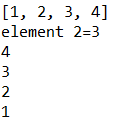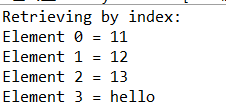李清华201772020113《面向对象程序设计(java)》第十一周学习总结
实验十一 集合
实验时间 2018-11-8
1、实验目的与要求
(1) 掌握Vetor、Stack、Hashtable三个类的用途及常用API;
(2) 了解java集合框架体系组成;
(3) 掌握ArrayList、LinkList两个类的用途及常用API。
(4) 了解HashSet类、TreeSet类的用途及常用API。
(5)了解HashMap、TreeMap两个类的用途及常用API;
(6) 结对编程(Pair programming)练习,体验程序开发中的两人合作。
2、实验内容和步骤
实验1: 导入第9章示例程序,测试程序并进行代码注释。
测试程序1:
l 使用JDK命令运行编辑、运行以下三个示例程序,结合运行结果理解程序;
掌握Vetor、Stack、Hashtable三个类的用途及常用API。
|
实验结果1

实验结果2

实验结果3

测试程序2:
使用JDK命令编辑运行ArrayListDemo和LinkedListDemo两个程序,结合程序运行结果理解程序;
|


l 在Elipse环境下编辑运行调试教材360页程序9-1,结合程序运行结果理解程序;
l 掌握ArrayList、LinkList两个类的用途及常用API。
package linkedList; import java.util.*; /**
* This program demonstrates operations on linked lists.
* @version 1.11 2012-01-26
* @author Cay Horstmann
*/
public class LinkedListTest
{
public static void main(String[] args)
{
List<String> a = new LinkedList<>();
a.add("Amy");
a.add("Carl");
a.add("Erica"); List<String> b = new LinkedList<>();
b.add("Bob");
b.add("Doug");
b.add("Frances");
b.add("Gloria"); // merge the words from b into a ListIterator<String> aIter = a.listIterator();
Iterator<String> bIter = b.iterator(); while (bIter.hasNext())
{
if (aIter.hasNext()) aIter.next();
aIter.add(bIter.next());
} System.out.println(a); // remove every second word from b bIter = b.iterator();
while (bIter.hasNext())
{
bIter.next(); // skip one element
if (bIter.hasNext())
{
bIter.next(); // skip next element
bIter.remove(); // remove that element
}
} System.out.println(b); // bulk operation: remove all words in b from a a.removeAll(b); System.out.println(a);
}
}

测试程序3:
l 运行SetDemo程序,结合运行结果理解程序;
|
import java.util.*; public class SetDemo { public static void main(String[] argv) { HashSet h = new HashSet(); //也可以 Set h=new HashSet() h.add("One"); h.add("Two"); h.add("One"); // DUPLICATE h.add("Three"); Iterator it = h.iterator(); while (it.hasNext()) { System.out.println(it.next()); } } } |

l 在Elipse环境下调试教材365页程序9-2,结合运行结果理解程序;了解HashSet类的用途及常用API。
package set; import java.util.*; /**
* This program uses a set to print all unique words in System.in.
* @version 1.12 2015-06-21
* @author Cay Horstmann
*/
public class SetTest
{
public static void main(String[] args)
{
Set<String> words = new HashSet<>(); // HashSet implements Set
long totalTime = 0; try (Scanner in = new Scanner(System.in))
{
while (in.hasNext())
{
String word = in.next();
long callTime = System.currentTimeMillis();
words.add(word);
callTime = System.currentTimeMillis() - callTime;
totalTime += callTime;
}
} Iterator<String> iter = words.iterator();
for (int i = 1; i <= 20 && iter.hasNext(); i++)
System.out.println(iter.next());
System.out.println(". . .");
System.out.println(words.size() + " distinct words. " + totalTime + " milliseconds.");
}
}
l 在Elipse环境下调试教材367页-368程序9-3、9-4,结合程序运行结果理解程序;了解TreeSet类的用途及常用API。
package treeSet; import java.util.*; /**
* An item with a description and a part number.
*/
public class Item implements Comparable<Item>
{
private String description;
private int partNumber; /**
* Constructs an item.
*
* @param aDescription
* the item's description
* @param aPartNumber
* the item's part number
*/
public Item(String aDescription, int aPartNumber)
{
description = aDescription;
partNumber = aPartNumber;
} /**
* Gets the description of this item.
*
* @return the description
*/
public String getDescription()
{
return description;
} public String toString()
{
return "[description=" + description + ", partNumber=" + partNumber + "]";
} public boolean equals(Object otherObject)
{
if (this == otherObject) return true;
if (otherObject == null) return false;
if (getClass() != otherObject.getClass()) return false;
Item other = (Item) otherObject;
return Objects.equals(description, other.description) && partNumber == other.partNumber;
} public int hashCode()
{
return Objects.hash(description, partNumber);
} public int compareTo(Item other)
{
int diff = Integer.compare(partNumber, other.partNumber);
return diff != 0 ? diff : description.compareTo(other.description);
}
}
package treeSet; import java.util.*; /**
* This program sorts a set of item by comparing their descriptions.
* @version 1.12 2015-06-21
* @author Cay Horstmann
*/
public class TreeSetTest
{
public static void main(String[] args)
{
SortedSet<Item> parts = new TreeSet<>();
parts.add(new Item("Toaster", 1234));
parts.add(new Item("Widget", 4562));
parts.add(new Item("Modem", 9912));
System.out.println(parts); NavigableSet<Item> sortByDescription = new TreeSet<>(
Comparator.comparing(Item::getDescription)); sortByDescription.addAll(parts);
System.out.println(sortByDescription);
}
}

测试程序4:
使用JDK命令运行HashMapDemo程序,结合程序运行结果理解程序;
|
import java.util.*; public class HashMapDemo { public static void main(String[] argv) { HashMap h = new HashMap(); // The hash maps from company name to address. h.put("Adobe", "Mountain View, CA"); h.put("IBM", "White Plains, NY"); h.put("Sun", "Mountain View, CA"); String queryString = "Adobe"; String resultString = (String)h.get(queryString); System.out.println("They are located in: " + resultString); } } |
实验结果:

l 在Elipse环境下调试教材373页程序9-6,结合程序运行结果理解程序;
l 了解HashMap、TreeMap两个类的用途及常用API。
package map; import java.util.*; /**
* This program demonstrates the use of a map with key type String and value type Employee.
* @version 1.12 2015-06-21
* @author Cay Horstmann
*/
public class MapTest
{
public static void main(String[] args)
{
Map<String, Employee> staff = new HashMap<>();
staff.put("144-25-5464", new Employee("Amy Lee"));
staff.put("567-24-2546", new Employee("Harry Hacker"));
staff.put("157-62-7935", new Employee("Gary Cooper"));
staff.put("456-62-5527", new Employee("Francesca Cruz")); // print all entries System.out.println(staff); // remove an entry staff.remove("567-24-2546"); // replace an entry staff.put("456-62-5527", new Employee("Francesca Miller")); // look up a value System.out.println(staff.get("157-62-7935")); // iterate through all entries staff.forEach((k, v) ->
System.out.println("key=" + k + ", value=" + v));
}
}
package map; /**
* A minimalist employee class for testing purposes.
*/
public class Employee
{
private String name;
private double salary; /**
* Constructs an employee with $0 salary.
* @param n the employee name
*/
public Employee(String name)
{
this.name = name;
salary = 0;
} public String toString()
{
return "[name=" + name + ", salary=" + salary + "]";
}
}
实验结果:

实验2:结对编程练习:
l 关于结对编程:以下图片是一个结对编程场景:两位学习伙伴坐在一起,面对着同一台显示器,使用着同一键盘,同一个鼠标,他们一起思考问题,一起分析问题,一起编写程序。

l 关于结对编程的阐述可参见以下链接:
http://www.cnblogs.com/xinz/archive/2011/08/07/2130332.html
http://en.wikipedia.org/wiki/Pair_programming
l 对于结对编程中代码设计规范的要求参考:
http://www.cnblogs.com/xinz/archive/2011/11/20/2255971.html
以下实验,就让我们来体验一下结对编程的魅力。
l 确定本次实验结对编程合作伙伴;
l 各自运行合作伙伴实验九编程练习1,结合使用体验对所运行程序提出完善建议;
package test1; import java.io.BufferedReader;
import java.io.File;
import java.io.FileInputStream;
import java.io.FileNotFoundException;
import java.io.IOException;
import java.io.InputStreamReader;
import java.util.ArrayList;
import java.util.Collections;
import java.util.Scanner; public class Main{
private static ArrayList<Student> studentlist;
public static void main(String[] args) {
studentlist = new ArrayList<>();
Scanner scanner = new Scanner(System.in);
File file = new File("F:\\身份证号.txt");
try {
FileInputStream fis = new FileInputStream(file);
BufferedReader in = new BufferedReader(new InputStreamReader(fis));
String temp = null;
while ((temp = in.readLine()) != null) { Scanner linescanner = new Scanner(temp); linescanner.useDelimiter(" ");
String name = linescanner.next();
String number = linescanner.next();
String sex = linescanner.next();
String age = linescanner.next();
String province =linescanner.nextLine();
Student student = new Student();
student.setName(name);
student.setnumber(number);
student.setsex(sex);
int a = Integer.parseInt(age);
student.setage(a);
student.setprovince(province);
studentlist.add(student); }
} catch (FileNotFoundException e) {
System.out.println("学生信息文件找不到");
e.printStackTrace();
} catch (IOException e) {
System.out.println("学生信息文件读取错误");
e.printStackTrace();
}
boolean isTrue = true;
while (isTrue) {
System.out.println("选择你的操作,输入正确格式的选项");
System.out.println("A.按姓名字典排序");
System.out.println("B.输出年龄最大和年龄最小的人");
System.out.println("C.寻找老乡");
System.out.println("D.寻找年龄相近的人");
System.out.println("F.退出");
String m = scanner.next();
switch (m) {
case "A":
Collections.sort(studentlist);
System.out.println(studentlist.toString());
break;
case "B":
int max=0,min=100;
int j,k1 = 0,k2=0;
for(int i=1;i<studentlist.size();i++)
{
j=studentlist.get(i).getage();
if(j>max)
{
max=j;
k1=i;
}
if(j<min)
{
min=j;
k2=i;
} }
System.out.println("年龄最大:"+studentlist.get(k1));
System.out.println("年龄最小:"+studentlist.get(k2));
break;
case "C":
System.out.println("老家?");
String find = scanner.next();
String place=find.substring(0,3);
for (int i = 0; i <studentlist.size(); i++)
{
if(studentlist.get(i).getprovince().substring(1,4).equals(place))
System.out.println("老乡"+studentlist.get(i));
}
break; case "D":
System.out.println("年龄:");
int yourage = scanner.nextInt();
int near=agenear(yourage);
int value=yourage-studentlist.get(near).getage();
System.out.println(""+studentlist.get(near));
break;
case "F":
isTrue = false;
System.out.println("退出程序!");
break;
default:
System.out.println("输入有误"); }
}
}
public static int agenear(int age) {
int j=0,min=53,value=0,k=0;
for (int i = 0; i < studentlist.size(); i++)
{
value=studentlist.get(i).getage()-age;
if(value<0) value=-value;
if (value<min)
{
min=value;
k=i;
}
}
return k;
} }
package test1;
public class Student implements Comparable<Student> {
private String name;
private String number ;
private String sex ;
private int age;
private String province;
public String getName() {
return name;
}
public void setName(String name) {
this.name = name;
}
public String getnumber() {
return number;
}
public void setnumber(String number) {
this.number = number;
}
public String getsex() {
return sex ;
}
public void setsex(String sex ) {
this.sex =sex ;
}
public int getage() {
return age;
}
public void setage(int age) {
// int a = Integer.parseInt(age);
this.age= age;
}
public String getprovince() {
return province;
}
public void setprovince(String province) {
this.province=province ;
}
public int compareTo(Student o) {
return this.name.compareTo(o.getName());
}
public String toString() {
return name+"\t"+sex+"\t"+age+"\t"+number+"\t"+province+"\n";
}
}
完善建议:无
l 各自运行合作伙伴实验十编程练习2,结合使用体验对所运行程序提出完善建议;
package shiyan;
import java.util.Scanner;
import java.io.FileNotFoundException;
import java.io.PrintWriter; public class Main {
public static void main(String[] args) {
Scanner in=new Scanner(System.in);
PrintWriter output = null;
try {
output = new PrintWriter("E:/test.txt");
} catch (FileNotFoundException e) {
// TODO 自动生成的 catch 块
System.out.println("文件输出失败");
e.printStackTrace();
}
int sum=0;
jisuanji js=new jisuanji();
for (int i = 0; i < 10; i++) {
int a = (int) Math.round(Math.random() * 100);
int b = (int) Math.round(Math.random() * 100);
int n = (int) Math.round(Math.random() * 4 ); switch(n)
{
case 1:
System.out.println(a+"/"+b+"=");
while(b==0){
b = (int) Math.round(Math.random() * 100);
}
while(a%b!=0) {
a = (int) Math.round(Math.random() * 100);
b = (int) Math.round(Math.random() * 100);
}
double c = in.nextDouble();
output.println(a+"/"+b+"="+c);
if (c == js.chu(a,b)) {
sum += 10;
System.out.println("答案正确");
}
else {
System.out.println("答案错误");
} break; case 2:
System.out.println(a+"*"+b+"=");
int c1 = in.nextInt();
output.println(a+"*"+b+"="+c1);
if (c1 == js.chen(a, b)) {
sum += 10;
System.out.println("答案正确");
}
else {
System.out.println("答案错误");
}
break;
case 3:
System.out.println(a+"+"+b+"=");
int c2 = in.nextInt();
output.println(a+"+"+b+"="+c2);
if (c2 == js.jia(a, b)) {
sum += 10;
System.out.println("答案正确");
}
else {
System.out.println("答案错误");
} break ;
case 4:
System.out.println(a+"-"+b+"=");
while(a<b) {
a = (int) Math.round(Math.random() * 100);
b = (int) Math.round(Math.random() * 100);
}
int c3 = in.nextInt();
output.println(a+"-"+b+"="+c3);
if (c3 == js.jian(a,b)) {
sum += 10;
System.out.println("答案正确");
}
else {
System.out.println("答案错误");
}
break ; } }
System.out.println("成绩"+sum);
output.println("成绩:"+sum);
output.close();
}
}
package shiyan;
public class jisuanji<T> {
private T a;
private T b;
public jisuanji() {
a=null;
b=null;
}
public jisuanji(T a,T b) {
this.a=a;
this.b=b;
}
public int jia(int a,int b)
{
return a+b;
}
public int jian(int a,int b)
{
return a-b;
}
public int chen(int a,int b)
{
return a*b;
}
public int chu(int a,int b)
{
if(b!=0&&a%b==0)
return a/b;
else
return 0;
}
}
完善建议:jisuanji类的除法的一些限制条件多余,可以不写,简化代码。
l 采用结对编程方式,与学习伙伴合作完成实验九编程练习1;
package test1; import java.io.BufferedReader;
import java.io.File;
import java.io.FileInputStream;
import java.io.FileNotFoundException;
import java.io.IOException;
import java.io.InputStreamReader;
import java.util.ArrayList;
import java.util.Collections;
import java.util.Scanner; public class Main{
private static ArrayList<Student> studentlist;
public static void main(String[] args) {
studentlist = new ArrayList<>();
Scanner scanner = new Scanner(System.in);
File file = new File("F:\\身份证号.txt");
try {
FileInputStream fis = new FileInputStream(file);
BufferedReader in = new BufferedReader(new InputStreamReader(fis));
String temp = null;
while ((temp = in.readLine()) != null) { Scanner linescanner = new Scanner(temp); linescanner.useDelimiter(" ");
String name = linescanner.next();
String number = linescanner.next();
String sex = linescanner.next();
String age = linescanner.next();
String province =linescanner.nextLine();
Student student = new Student();
student.setName(name);
student.setnumber(number);
student.setsex(sex);
int a = Integer.parseInt(age);
student.setage(a);
student.setprovince(province);
studentlist.add(student); }
} catch (FileNotFoundException e) {
System.out.println("学生信息文件找不到");
e.printStackTrace();
} catch (IOException e) {
System.out.println("学生信息文件读取错误");
e.printStackTrace();
}
boolean isTrue = true;
while (isTrue) {
System.out.println("选择你的操作,输入正确格式的选项");
System.out.println("A.按姓名字典排序");
System.out.println("B.输出年龄最大和年龄最小的人");
System.out.println("C.寻找老乡");
System.out.println("D.寻找年龄相近的人");
System.out.println("F.退出");
String m = scanner.next();
switch (m) {
case "A":
Collections.sort(studentlist);
System.out.println(studentlist.toString());
break;
case "B":
int max=0,min=100;
int j,k1 = 0,k2=0;
for(int i=1;i<studentlist.size();i++)
{
j=studentlist.get(i).getage();
if(j>max)
{
max=j;
k1=i;
}
if(j<min)
{
min=j;
k2=i;
} }
System.out.println("年龄最大:"+studentlist.get(k1));
System.out.println("年龄最小:"+studentlist.get(k2));
break;
case "C":
System.out.println("老家?");
String find = scanner.next();
String place=find.substring(0,3);
for (int i = 0; i <studentlist.size(); i++)
{
if(studentlist.get(i).getprovince().substring(1,4).equals(place))
System.out.println("老乡"+studentlist.get(i));
}
break; case "D":
System.out.println("年龄:");
int yourage = scanner.nextInt();
int near=agenear(yourage);
int value=yourage-studentlist.get(near).getage();
System.out.println(""+studentlist.get(near));
break;
case "F":
isTrue = false;
System.out.println("退出程序!");
break;
default:
System.out.println("输入有误"); }
}
}
public static int agenear(int age) {
int j=0,min=53,value=0,k=0;
for (int i = 0; i < studentlist.size(); i++)
{
value=studentlist.get(i).getage()-age;
if(value<0) value=-value;
if (value<min)
{
min=value;
k=i;
}
}
return k;
} }
package test1;
public class Student implements Comparable<Student> {
private String name;
private String number ;
private String sex ;
private int age;
private String province;
public String getName() {
return name;
}
public void setName(String name) {
this.name = name;
}
public String getnumber() {
return number;
}
public void setnumber(String number) {
this.number = number;
}
public String getsex() {
return sex ;
}
public void setsex(String sex ) {
this.sex =sex ;
}
public int getage() {
return age;
}
public void setage(int age) {
// int a = Integer.parseInt(age);
this.age= age;
}
public String getprovince() {
return province;
}
public void setprovince(String province) {
this.province=province ;
}
public int compareTo(Student o) {
return this.name.compareTo(o.getName());
}
public String toString() {
return name+"\t"+sex+"\t"+age+"\t"+number+"\t"+province+"\n";
}
}
l 采用结对编程方式,与学习伙伴合作完成实验十编程练习2。
package shiyan;
import java.util.Scanner;
import java.io.FileNotFoundException;
import java.io.PrintWriter; public class Main {
public static void main(String[] args) {
Scanner in=new Scanner(System.in);
PrintWriter output = null;
try {
output = new PrintWriter("E:/test.txt");
} catch (FileNotFoundException e) {
// TODO 自动生成的 catch 块
System.out.println("文件输出失败");
e.printStackTrace();
}
int sum=0;
jisuanji js=new jisuanji();
for (int i = 0; i < 10; i++) {
int a = (int) Math.round(Math.random() * 100);
int b = (int) Math.round(Math.random() * 100);
int n = (int) Math.round(Math.random() * 4 ); switch(n)
{
case 1:
System.out.println(a+"/"+b+"=");
while(b==0){
b = (int) Math.round(Math.random() * 100);
}
while(a%b!=0) {
a = (int) Math.round(Math.random() * 100);
b = (int) Math.round(Math.random() * 100);
}
double c = in.nextDouble();
output.println(a+"/"+b+"="+c);
if (c == js.chu(a,b)) {
sum += 10;
System.out.println("答案正确");
}
else {
System.out.println("答案错误");
} break; case 2:
System.out.println(a+"*"+b+"=");
int c1 = in.nextInt();
output.println(a+"*"+b+"="+c1);
if (c1 == js.chen(a, b)) {
sum += 10;
System.out.println("答案正确");
}
else {
System.out.println("答案错误");
}
break;
case 3:
System.out.println(a+"+"+b+"=");
int c2 = in.nextInt();
output.println(a+"+"+b+"="+c2);
if (c2 == js.jia(a, b)) {
sum += 10;
System.out.println("答案正确");
}
else {
System.out.println("答案错误");
} break ;
case 4:
System.out.println(a+"-"+b+"=");
while(a<b) {
a = (int) Math.round(Math.random() * 100);
b = (int) Math.round(Math.random() * 100);
}
int c3 = in.nextInt();
output.println(a+"-"+b+"="+c3);
if (c3 == js.jian(a,b)) {
sum += 10;
System.out.println("答案正确");
}
else {
System.out.println("答案错误");
}
break ; } }
System.out.println("成绩"+sum);
output.println("成绩:"+sum);
output.close();
}
}
package shiyan;
public class jisuanji<T> {
private T a;
private T b;
public jisuanji() {
a=null;
b=null;
}
public jisuanji(T a,T b) {
this.a=a;
this.b=b;
}
public int jia(int a,int b)
{
return a+b;
}
public int jian(int a,int b)
{
return a-b;
}
public int chen(int a,int b)
{
return a*b;
}
public int chu(int a,int b)
{
if(b!=0&&a%b==0)
return a/b;
else
return 0;
}
}
本周实验总结:
学会了一些简单的数据结构,例如链,栈,队列,散列表等。还有Java的集合框架,集合类的内容。
复习了前面学过的知识细节,例如强制转换类型时进行判断的instanceof语句。初步体会了合作编程,互相提高的过程和乐趣。
李清华201772020113《面向对象程序设计(java)》第十一周学习总结的更多相关文章
- 201771010134杨其菊《面向对象程序设计java》第九周学习总结
第九周学习总结 第一部分:理论知识 异常.断言和调试.日志 1.捕获 ...
- 201871010132-张潇潇《面向对象程序设计(java)》第一周学习总结
面向对象程序设计(Java) 博文正文开头 项目 内容 这个作业属于哪个课程 https://www.cnblogs.com/nwnu-daizh/ 这个作业的要求在哪里 https://www.cn ...
- 扎西平措 201571030332《面向对象程序设计 Java 》第一周学习总结
<面向对象程序设计(java)>第一周学习总结 正文开头: 项目 内容 这个作业属于哪个课程 https://www.cnblogs.com/nwnu-daizh/ 这个作业的要求在哪里 ...
- 杨其菊201771010134《面向对象程序设计Java》第二周学习总结
第三章 Java基本程序设计结构 第一部分:(理论知识部分) 本章主要学习:基本内容:数据类型:变量:运算符:类型转换,字符串,输入输出,控制流程,大数值以及数组. 1.基本概念: 1)标识符:由字母 ...
- 201871010124 王生涛《面向对象程序设计JAVA》第一周学习总结
项目 内容 这个作业属于哪个课程 https://www.cnblogs.com/nwnu-daizh/ 这个作业的要求在哪里 https://edu.cnblogs.com/campus/xbsf/ ...
- 201871010115——马北《面向对象程序设计JAVA》第二周学习总结
项目 内容 这个作业属于哪个课程 https://www.cnblogs.com/nwnu-daizh/ 这个作业的要求在哪里 https://www.cnblogs.com/nwnu-daizh/p ...
- 201777010217-金云馨《面向对象程序设计(Java)》第二周学习总结
项目 内容 这个作业属于哪个课程 https://www.cnblogs.com/nwnu-daizh/ 这个作业的要求在哪里 https://www.cnblogs.com/nwnu-daizh/p ...
- 201871010132——张潇潇《面向对象程序设计JAVA》第二周学习总结
项目 内容 这个作业属于哪个课程 https://www.cnblogs.com/nwnu-daizh/ 这个作业的要求在哪里 https://www.cnblogs.com/nwnu-daizh/p ...
- 201771010123汪慧和《面向对象程序设计Java》第二周学习总结
一.理论知识部分 1.标识符由字母.下划线.美元符号和数字组成, 且第一个符号不能为数字.标识符可用作: 类名.变量名.方法名.数组名.文件名等.第二部分:理论知识学习部分 2.关键字就是Java语言 ...
- 20172325 2017-2018-2 《Java程序设计》第十一周学习总结
20172325 2017-2018-2 <Java程序设计>第十一周学习总结 教材学习内容总结 Android简介 Android操作系统是一种多用户的Linux系统,每个应用程序作为单 ...
随机推荐
- 安装Scala开发环境
Scala 介绍 Step 1: 安装 Java开发环境 Scala 版本与Java版本的兼容关系 从Oracle网站下载JDK URL: http://www.oracle.com/technetw ...
- 一、Flask路由介绍
Flask介绍(轻量级的框架,非常快速的就能把程序搭建起来) Flask是一个基于Python开发并且依赖jinja2模板和Werkzeug WSGI服务的一个微型框架,对于Werkzeug本质是So ...
- JavaScript线程(第八天)
js是单线程的: js中的线程分为三种 1.页面渲染 2.主代码逻辑 3.事件触发: 下面我们来看一段代码 <script> setTimeout(function(){ conso ...
- 添加ssl证书
ssl证书会使你的网站更加安全,防止isp在你的网站显示时添加广告,浏览网页时地址栏左边有一个绿色安全的图标,使用户感觉更加安全放心. 颁发ssl证书的机构很多,有收费的,也有免费的.当然对于自己的小 ...
- EBS WEBADI导入日记账 客户化账户组合规则校验
近期项目需求对EBS中WEBADI导入日记账时,在加载数据时需要对账户组合额外进行客户化的校验,需要能够做到将校验结果体现在WEBADI模板的数据上,并且对每条错误数据都单独报错. 项目上的方案是调整 ...
- iTrash for Mac(卸载工具)破解版含注册机
iTrash for Mac是一款专为Mac用户打造非常好用的卸载工具,itrash mac版简单好用,只需要把需要卸载的程序的拖拽到iTrash Mac版窗口内就可以删除应用程序.现为大家带来itr ...
- Linux----------rsync的介绍及安装使用
目录 一.rsync的介绍 1.1rsync的特点 二.rsync命令 三.rsync的ssh认证协议 四.ssh协议方式使用方法 五.rsync协议方式使用方法即 (rsync + inotifu- ...
- return,break,continue三者区别
详解:http://www.cnblogs.com/yangdabao/p/6172210.html return:直接结束这个方法,后面所有代码不再执行,不管循坏外,还是循环内,全部停止,直接返回 ...
- edgedb 内部pg 数据存储的探索 (四) 源码编译
edgedb 基于python开发,同时源码重包含了好多子项目,以下进行简单的源码编译 clone 代码 需要递归处理,加上recursive,比较慢稍等 git clone --recursiv ...
- Kafka win10下启动
启动kafka之前先要启动zookeeper,而kafka里面时自带有zookeeper的,建议独立部署一套zookeeper服务,kafka下的zookeeper启动命令: zookeeper-s ...
